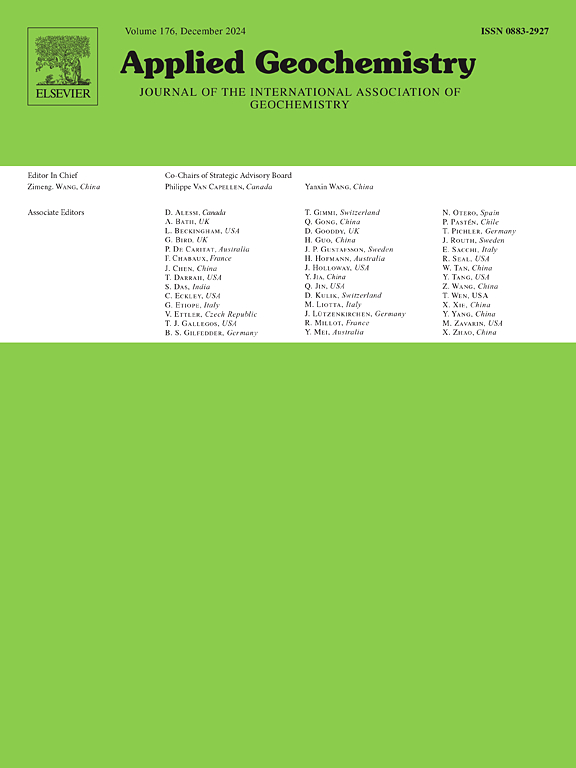Increasing anthropogenic contributions on hydrochemical evolution of groundwater in the Yellow River basin over the past decade
IF 3.4
3区 地球科学
Q1 GEOCHEMISTRY & GEOPHYSICS
引用次数: 0
Abstract
The temporal evolution of groundwater chemistry is crucial for guiding sustainable water resource management. In China, the Yellow River Basin features active geological structures, diverse lithology, and significant human impacts, leading to unclear patterns and factors governing groundwater chemistry evolution. In this study, we investigated the characteristics, sources, and controlling factors of groundwater chemistry in the Yellow River Basin during the period of 2011–2022, with a view to providing guidance for water chemistry management in the region. The results indicate that over time, major ions (Na+, Mg2+, Cl−, SO42−, NO3−, and F−) in the Yellow River Basin's groundwater rise then fall, with pH initially increasing before stabilizing at a mild alkaline level. The anions in groundwater chemistry are dominated by HCO3−, which accounts for 38.89–60.78% of the anion concentration equivalent, and cations are dominated by Na+, which accounts for 31.43–72.22%. Hydrochemical types shift among HCO3–Ca, Cl–SO4–Na, and mixed HCO3–Ca–Mg, with Cl–SO4–Na type correlating positively with human activity level. Dissolution of minerals are the primary sources of groundwater chemistry. Hydrochemical evolution is driven by rock weathering alongside human activities such as sewage discharge and fertilizer application. Initially, mineral weathering was the key factor, with the chemical composition becoming dynamically altered as human activity increased. In summary, the groundwater chemistry in the Yellow River Basin mainly stems from mineral reactions, initially by rock weathering and later affected by rising human activities. This study advances knowledge of groundwater geochemical dynamics in the Yellow River Basin, supporting improved management and sustainable water resource use.
近十年来,黄河流域地下水水化学演化的人为影响越来越大
地下水化学的时间演变对指导水资源的可持续管理具有重要意义。在中国,黄河流域地质构造活跃,岩性多样,人类活动影响显著,导致地下水化学演化的模式和因素不明确。本研究对2011-2022年黄河流域地下水化学特征、来源及控制因素进行了研究,以期为该地区水化学管理提供指导。结果表明:随着时间的推移,黄河流域地下水主要离子(Na+、Mg2+、Cl−、SO42−、NO3−和F−)呈先升后降的趋势,pH值先升高后稳定在温和碱性水平;地下水化学阴离子以HCO3−为主,占阴离子浓度当量的38.89 ~ 60.78%,阳离子以Na+为主,占31.43 ~ 72.22%。水化学类型在HCO3-Ca、Cl-SO4-Na和混合HCO3-Ca - mg之间转换,其中Cl-SO4-Na类型与人类活动水平呈正相关。矿物的溶解是地下水化学的主要来源。水化学演化是由岩石风化以及人类活动(如污水排放和肥料施用)驱动的。最初,矿物风化是关键因素,随着人类活动的增加,化学成分会发生动态变化。综上所述,黄河流域地下水化学主要源于矿物反应,最初受岩石风化作用的影响,后来受人类活动加剧的影响。本研究促进了对黄河流域地下水地球化学动力学的认识,为改善水资源管理和可持续利用提供了支持。
本文章由计算机程序翻译,如有差异,请以英文原文为准。
求助全文
约1分钟内获得全文
求助全文
来源期刊

Applied Geochemistry
地学-地球化学与地球物理
CiteScore
6.10
自引率
8.80%
发文量
272
审稿时长
65 days
期刊介绍:
Applied Geochemistry is an international journal devoted to publication of original research papers, rapid research communications and selected review papers in geochemistry and urban geochemistry which have some practical application to an aspect of human endeavour, such as the preservation of the environment, health, waste disposal and the search for resources. Papers on applications of inorganic, organic and isotope geochemistry and geochemical processes are therefore welcome provided they meet the main criterion. Spatial and temporal monitoring case studies are only of interest to our international readership if they present new ideas of broad application.
Topics covered include: (1) Environmental geochemistry (including natural and anthropogenic aspects, and protection and remediation strategies); (2) Hydrogeochemistry (surface and groundwater); (3) Medical (urban) geochemistry; (4) The search for energy resources (in particular unconventional oil and gas or emerging metal resources); (5) Energy exploitation (in particular geothermal energy and CCS); (6) Upgrading of energy and mineral resources where there is a direct geochemical application; and (7) Waste disposal, including nuclear waste disposal.
 求助内容:
求助内容: 应助结果提醒方式:
应助结果提醒方式:


